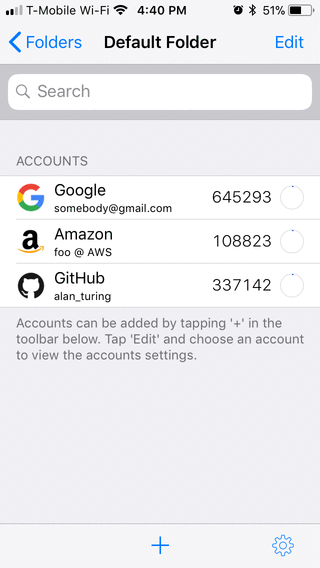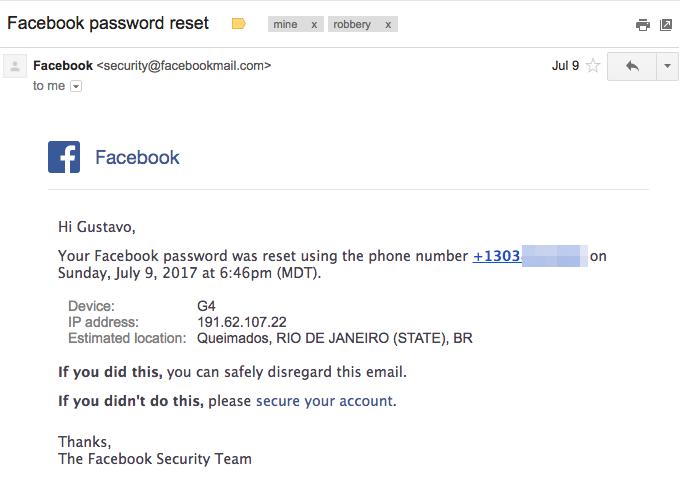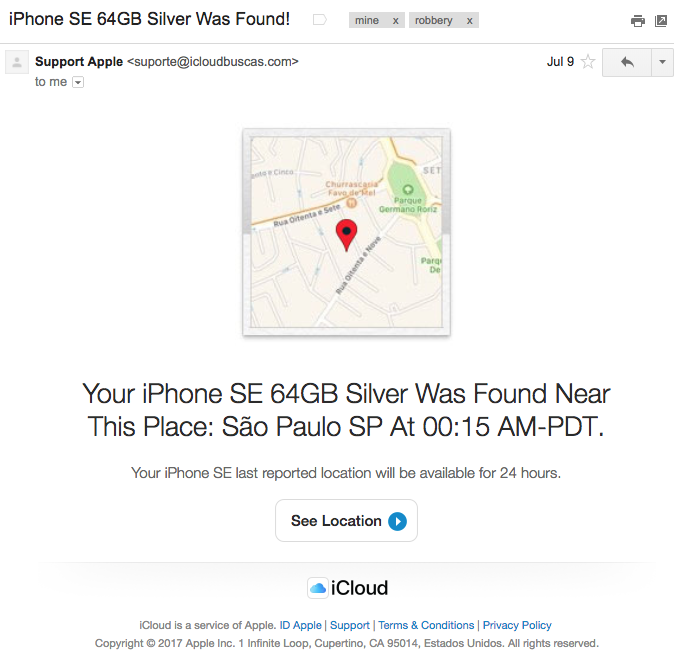(Some security recommendations are summarized at the end.)
I. The Robbery
This past summer I was walking around in the neighborhood where I grew up, happy-go-lucky, when some guy jumped off a motorcycle pointing a gun at me. It was my first time at gunpoint, and from the outset the weapon was positively spellbinding. As I gazed at it, strange thoughts hit me: “Am I going to get shot by this rusty piece of shit? What a sorry way to die! And what if I get tetanus?”
Those were thoughts I wouldn’t have anticipated, but as Dan Carlin says, humans in extreme situations often behave unexpectedly. And while a gun-toting thug is a far cry from the Battle of Verdun, it is pretty extreme for me. This post tells the story of the robbery and its surprising information security developments. There are lessons here for both users and designers of technology.

My daughter and I were visiting Brazil in July, taking a carefree walk in a boulevard lined with lush trees. She had just gotten into “good kid, m.A.A.d. city”, ironically enough an album about growing up in Compton amid dire violence. So we were deep in conversation about the US criminal justice system, drug laws, and the ideas of people like Bryan Stevenson and Michelle Alexander[1].
Growing up in Brazil you get a crash course in street smarts. I was mugged twice as a 10-year-old and once at 15. That’s counting only the times when stuff was actually taken. There were scores of near-muggings I dodged by either talking my way out or running my way out.
But after 20 trouble-free years, I let my guard down. Absorbed in conversation, I barely noticed the motorcycle driving on the other side of the street. By the time it veered the wrong way into traffic and sped towards the sidewalk we were on, it was too late. The passenger jumped out while the motorcycle was still moving, gun in hand pointed squarely at me.
The scene felt strangely removed - it’s cliche, but it really did feel like a movie. Instead of panicked confusion, there was a strong pragmatic voice in my head. I had thought about “what if” scenarios plenty of times before and they kicked in. Who is the attacker? What is their motivation? What’s the best course of action?
There are career criminals in Brazil who are downright professional. I know somebody whose house was invaded while they were home and the robbers let them know how long the “job” was going to take, offered them water, and made sure nobody freaked out. Better than some moving companies I’ve used.
But when someone is robbing random people on the street using a gun, that’s pretty far from professional. Way too volatile a situation with huge risks and beggarly payoff. These were at best lowlifes and at worst jittery crackheads. I felt two strong imperatives. First, keep the situation as absolutely relaxed as possible. When they get nervous, they get scared. And when they get scared, that’s when I accidentally get shot. But second, and more importantly: if they want to kidnap my daughter, fight it at any cost whatsoever. Better to die on that sidewalk than to let them take her.
I remember thinking, “take a deep breath, raise hands slowly, move smoothly, stay relaxed, hand everything over.” It worked. Who knows, maybe Andy from the Headspace app saved my life. The bandits were gone, along with our two iPhones and my watch. But the real fun was still to come.
After we got home, I logged into iCloud and put both phones in lost mode. They had been turned off, predictably. Plenty of crooks have been caught by way of “Find iPhone,” but they’ve learned by now. Thinking of my data in criminal hands was uncomfortable, but the fact that iOS exploits sell for $1.5 million made me feel a lot better. No small-timer is breaking into an iPhone. I figured they would wipe it out and sell it.
I have two-factor authentication in all the accounts that matter, and whenever possible my second factor is an iPhone app that generates time-based one-time passwords (TOTP) for authentication. Google Authenticator is a popular app for this, but I use OTP Auth instead because it is more flexible (more on this in the recommendations). Here’s what it looks like, slightly sped up to make it more exciting:

When it’s time to log into one of your accounts, you provide your login and password as you normally would, plus the temporary code being shown by the app.
I also use a password manager with unique, long passwords for each site. So my main concern at that point was minimizing the impact of this whole thing on my kid. We had dinner planned with friends, tasting menu at a good Japanese place, so I thought it best to go, have a good time, laugh and hopefully cushion the blow. Later I could call T-Mobile and suspend the cell lines.
II. The Hacking
A couple of hours later we were back, much happier, imbued with friendship and, in my case, plenty of sake. I opened Gmail and got some shockers:

Wuh-wait what? I wasn’t expecting to see any of these, but least of all the Facebook password reset. Before you read on, take a good look at those emails. It’s fun to work out what happened here. Done? Let’s dig in:

Whoah! Facebook password reset by phone number? How? Did they unlock my phone? But also… why? At once I felt the sinking realization I misread the situation. They seemed to be more sophisticated that I thought - not the motorcycle crew themselves, but someone else in the operation (his identity would be unmasked later that night).
The idea that somebody was hacking into my accounts right at that moment, with my phone in hand, was deeply unsettling. A malevolent twist to the emotional roller coaster of that evening. But this was a technical problem, so it was time to sober up as best as I could and work methodically.
The “how” was simple. The attacker took the SIM card out of the stolen iPhone and put it in another phone. At that point he found out my phone number, whereas previously he had no information on me. More importantly, he could also receive my SMS text messages. He then attempted to log into Facebook using my phone number as a login, clicked on “Forgot Password,” and reset the password via SMS.
So here is a big screw up and a couple of lessons. As I said, I have 2FA (two-factor authentication) in the accounts “that matter.” But I rarely use Facebook, so I didn’t enable 2FA there. Oops. Turns out it’s not such a great idea to have an account in the world’s most popular app as a weak link in your defenses.
Now consider Facebook’s account recovery policies. If the account has 2FA enabled, passwords can only be reset by email. That’s good. But without 2FA, if an account has an associated phone number, the password can be reset via SMS. In such a case, a SIM card is an instant ticket to the account: find it and reset its password in one fell swoop.
That’s a disaster. Facebook single handedly provides a way for attackers to go from a SIM card, or hijacked SMS messages, to a trove of personal information for the vast majority of people out there. By contrast, attackers made zero progress in hacking my kid’s accounts, mostly because she doesn’t use Facebook.
But why the hell was this wretch logging into my FB account? I suspect it wasn’t for my cousin’s mad political rants. Already shaken from the armed robbery, my mind played tricks on me as paranoid thoughts of identity theft and fraudulent bank transfers loomed.
I immediately logged into t-mobile.com and suspended both cell lines, disabling the attacker’s main weapon. As an aside, T-Mobile has been great for international travel. I love you guys, keep your website safe. I tested sending SMS messages to my suspended numbers and happily all attempts generated errors.
On to the other emails. The Facebook password reset arrived at 9:46pm Brazil time. Curiously, at 11:23pm they briefly turned my phone back on with its SIM card, and the phone went into lost mode and flashed on Find iPhone here. But then there is that fourth email with a subject line of “iPhone SE 64GB Silver Was Found!” arriving at 12:20am. Here it is:

The phone model and storage capacity are exactly right. The spelling, grammar, and layout are pretty well done. It was sent to my primary personal email, lifted from Facebook. Imagine a regular user receiving this right after their phone has been stolen, while they’re somewhat shaken, and when they’re not native English speakers to boot. What are the odds they’ll realize this is a phishing attempt for iCloud credentials?
Apart from checking the URL, the biggest clue is the exclamation mark in the subject line, a little too enthusiastic for Apple. Either way, this is a nearly perfect phishing piece, made more so by impeccable timing. Maybe iCloud accounts should be placed in some sort of restricted state after a device is put into lost mode.
It’s stressful to face an ongoing, targeted, personal attack. Deep breath again. Time to methodically check every account for suspicious activity, change passwords just in case, and recover compromised accounts. My main Google account, protected by 2FA, was safe throughout the ordeal. I reset my Facebook password by email and got back in. GitHub, AWS, and other professional accounts were also on 2FA and had no unauthorized activity. Audit logs never tasted so sweet. It was a relief knowing I wouldn’t have to tell clients, “Hey, how are you? Great! So, listen, this iPhone thieving ring probably has all your data, isn’t that funny? Hah! But never mind that! Those Bitcoin prices, huh?”
Then I tried a secondary Gmail account I use for some mailing lists and other non-critical tasks. You know… the kind of account for which one might leave 2FA disabled. Sure enough, the wretch had been there, and the password was changed via SMS password reset. And he only found the account by the phone number in the first place. Familiar? Here’s a quick recap:

This Gmail account did not have a recovery email set up, and ironically I couldn’t use SMS anymore. Google offers a recovery algorithm where you try to answer different questions with the ability to “Try another way” if you don’t have a particular answer (quick: in which month and year did you create your Google account?). I was locked out for a while, long enough to start thinking I had lost the account, but eventually produced a couple of answers and got back in.
Finally, all of my accounts were safe again. It was getting late, but I had to find out why this person was frantically probing my accounts, and maybe, with some luck, who they were.
I knew the data in the iPhones was safe, as per the Apple vs. government showdown after the San Bernardino terrorist attack. But earlier I had assumed the phones could still be wiped clean and used normally. But maybe they couldn’t, and this whole rigmarole was about breaking into my iCloud account. Hence the phishing.
A quick search confirmed the idea. Since iOS 7, released in 2013, Apple has provided the Activation Lock feature, whereby if a device is linked to an iCloud account, activating it requires the password to that account. This has created some misery among people buying and selling used iPhones: if the seller forgets to unlink the device from their iCloud account, the device is bricked until they do so.
A warm wave of righteous schadenfreude washed over me: all the robbers had were parts! They would fetch little money from this whole thing, especially since my kid’s screen was cracked. You go, kid! Glad I hadn’t replaced it yet. Also glad for activation lock, though perversely my digital torment was its side effect: the world is complicated. It turns out there was no sinister plot, just a miserable scheme for a few hundred dollars. Straight to the depths of hell is where those cowards going.
It was sobering to realize the attacker almost succeeded. Up until a few months prior to the robbery, my iCloud account did not have 2FA enabled and it used the compromised Gmail address as the recovery email. If the robbery had happened then, they would have been able to get in, unlink the phones, and sell them at full (used) price. They would have changed my iCloud password in the process, and might have erased and locked my other Apple devices for the hell of it, which would have been disastrous and possibly ruinous, depending on whether I could get back into the account. Whatever little data I have in iCloud would have been stolen as well.
I hope this motivates you to enable 2FA on all of your accounts, even the unimportant ones. They can interact in incremental and unexpected ways to become your undoing. Moreover, using TOTP apps as the second factor is far safer than SMS.
Apple has done a fantastic job with iOS security and Find iPhone, curbing everything from malware to exploits to theft. But further improvements can be made to better protect its customers. In the next post you’ll see week-long sustained hacking attempts and meet the maggot behind the attacks, operating in a wretched hive of “iPhone unlockers.”
III. Recommendations
-
Make sure your accounts cannot be hacked via text message (SMS) password resets. You can often do so by enabling two-factor authentication (2FA) for an account, particularly if you use a time-based one-time password (TOTP) app as the second factor. Two such apps are Google Authenticator and OTP Auth. You could also withhold your phone number from certain accounts. Another advantage of TOTP is that if you’re unable to receive SMS messages for whatever reason, you can still log in.
-
Beware of your unprotected “less critical” accounts. They might provide a path to your sensitive ones.
-
If you decide to go with a TOTP app, choose one that allows you to make an encrypted backup of your account secrets. OTP Auth provides that along with encrypted iCloud sync, all optional and controlled by the user. Authy is another good option. If you use Google Authenticator, make sure losing your phone won’t lock you out of any accounts.
-
If you design apps, be careful with password resets via SMS. SIM cards are an easy target, cell providers are subject to social engineering that could lead to intercepted messages[2], and SMS notifications can be seen on lock screens in most phones. Allow users to choose TOTP as a second factor.
-
If your iPhone is lost or stolen, go to iCloud.com immediately, put it in lost mode, and provide a phone number where you can be reached. Once you’ve done that, you might want to temporarily suspend your phone line (many carriers offer this on their websites). If you do so, you can no longer call your own phone, and unless it’s on wifi, you also can’t “Play Sound” or “Erase iPhone” via iCloud - keep that in mind. On the upside, nobody can use your SIM card to hack your accounts via SMS password reset. It’s a trade-off.
-
If your iPhone is definitely stolen, rather than lost, it will probably appear off in iCloud. Put it in lost mode anyway. If you provide a phone number, know that it might be targeted for iCloud phishing or social engineering as crooks try to hack into your iCloud account (that’s why the attacker briefly turned my phone on: to get a phone number to target). You almost surely want to suspend your cell service immediately. You lose the tracking and other goodies, but thieves generally know to keep the phone off, and handing them a working SIM card is fraught with peril. Tread carefully and may the force be with you.
-
You might want to protect your SIM card with a PIN. This requires you to enter the PIN whenever you turn your phone on. Attackers are thus unable to transplant your SIM card to another device and use it. However, if you lose your iPhone and the battery dies, or the person who finds it turns it off, it’s game over. Even if the phone is later turned on, it won’t connect to the Internet, enter Lost Mode, show a phone number where you can be reached, or “Play Sound” (this is true even if a known wifi is in range[3]). A phone that otherwise might have been found could be bricked and lost forever.
-
Beware of “Your iPhone was found” emails, text messages, and Whatsapp messages. Scammers attempt to phish for your iCloud credentials in devious ways soon after an iPhone is stolen. If you provided a lost mode phone number, thieves will attempt to use it against you while trying to break into your iCloud account.
-
Read Tech Solidarity’s security guide. It’s overkill for a regular user, but know the rules before breaking them.
Thank you for reading.
If you’re interested in US criminal justice, Ghettoside is a great book with better-than-fiction LA detective stories interwoven with a serious discussion of criminality, murder clearance rates, and other pressing topics. The New Jim Crow by Michelle Alexander is an interesting read on mass incarceration, while Bryan Stevenson’s Just Mercy offers a piercing look at the injustices we sometimes create. Ezra Klein has a good interview with Stevenson. Glenn Loury’s interview with Sam Harris offers a somewhat different perspective. ↩︎
VICE reported on a T-Mobile website bug that leaked personal data based based on phone number alone, giving social engineers a leg up. But this type of attack has worked against multiple carriers all over the world. Prominent [hacks] wired-deray-hack have happened this way. ↩︎
You can try this at home: turn your iPhone off and back on. Until the passcode is entered at least once, it won’t connect to wifi. See this. If you have a better link, please let me know. ↩︎
Comments